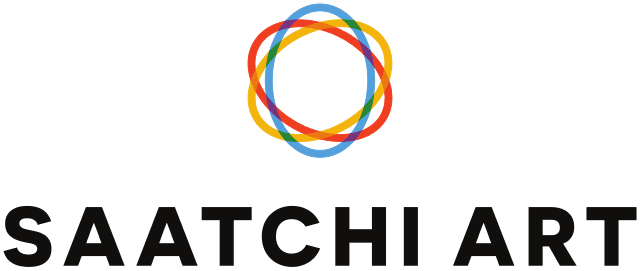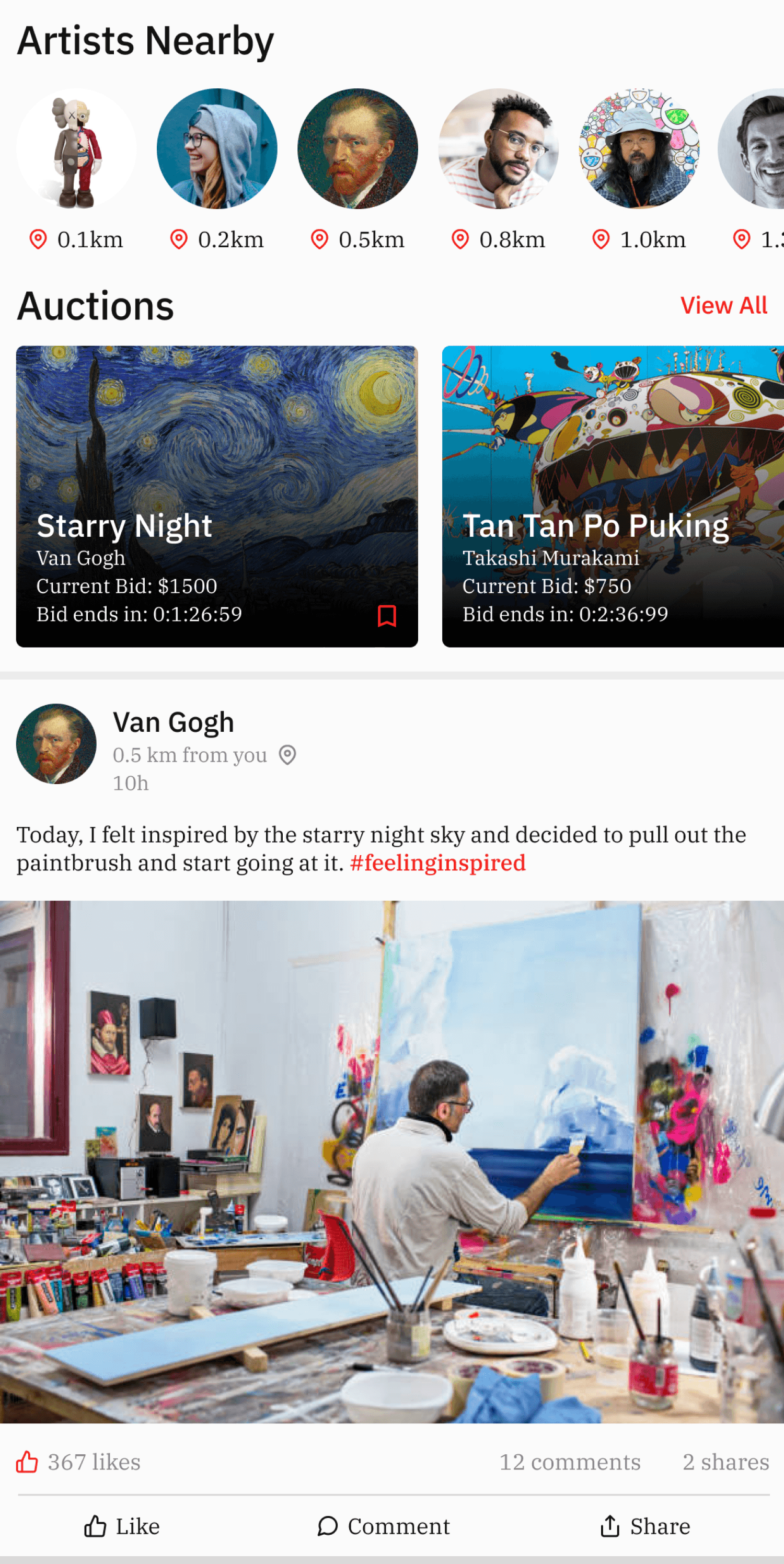
In Fall 2024, I collaborated with 4 UX Designers in a master's course to address emerging artists' challenges, drawing from our own experiences in selling art. We conducted interviews to uncover pain points, developed a location-based marketplace concept, designed and tested user flows for buyers and artists, and refined the solution through usability testing.
Emerging artists often struggle to break into the art market and creative industries, making it challenging to sustain their artistic practice.
role
UX/UI Designer
team
1 UX Researcher, 4 UX/UI Designers
Timeline
3 months
ux deliverables
UX research, competitive analysis, user flow, artist & buyer wireframes, interactive prototypes, and usability testing.
Marketspace
Art
AR
inspiration
Lesson from closing my Etsy shop.
At the start of this year, I launched a Etsy shop to sell my crochet crafts. My first creation was a flower bookmark, crafted over 2 hours and priced at $25 CAD.
Excited yet nervous, I waited for my first sale—but no one came. Determined to succeed, I lowered the price, then lowered it again. Still, the orders didn’t come.
The effort I put into each piece far exceeded what the market would pay, leaving me stuck and unsure how to promote my shop. Unable to sell without a loss, I closed my Etsy shop, disheartened but reflective.
I'm not the only one. Only 26% of Etsy shops are successful and take as a full-time business. The main reason for this is the competition; there are over 7.52 million active shops on Etsy, so it can be difficult to stand out from the crowd.
Resource: https://www.contimod.com/etsy-statistics/
problem space
research
Walk in both shoes to see the full story.
Closing a deal is a 2-way street.
To understand how to sell art, we researched the stakeholders involved in art sales, focusing on artists' motivations, buyers' behaviors, and the platforms they use. With only one week to recruit and conduct interviews, we prioritized interviewing artists and relied on secondary research to analyze buyer behavior, effectively addressing both perspectives.
Secondary research on artists
17 resources, including papers, reports, and articles
Interviews
10 X 30 min interview with artists
Secondary research on buyers
2 annual reports from art sale platforms
Artists fight to be seen and valued in a crowded, undervalued market.
Desire for Connection & Visibility:
7/10 seek deeper audience connections, while 8/10 feel frustrated by limited online exposure, making it harder to build meaningful relationships.
Art Devaluation & Platform Diversity:
7/10 feel undervalued due to market saturation and lack of appreciation for effort, driving 8/10 to use multiple platforms to showcase their work.
Art buyers value emotional connection but struggle to trust online experiences.
Motivations & Barriers:
Buyers value emotional connection, community, and investment but are hindered by the inability to view art in person and concerns over online visual discrepancies.
Art Devaluation & Platform Diversity:
7/10 feel undervalued due to market saturation and lack of appreciation for effort, driving 8/10 to use multiple platforms to showcase their work.
Resource: https://www.hiscox.co.uk/sites/default/files/documents/2023-04/Hiscox%20online%20art%20trade%20report%202023.pdf
Our direct competitors fail to fill the gap.
Learning from interviews, artists use both digital and physical platforms to complement each other's shortcomings.
A competitor analysis of digital platforms for exhibiting and selling art, as well as traditional non-digital channels.

Artsy
High-end art marketplace
Global reach
Professional market
Requires gallery representation
High competition
Saatchi Art
Artist-focused marketplace
Supports emerging artists
Guidance for pricing and marketing
Need promotion
High commissions
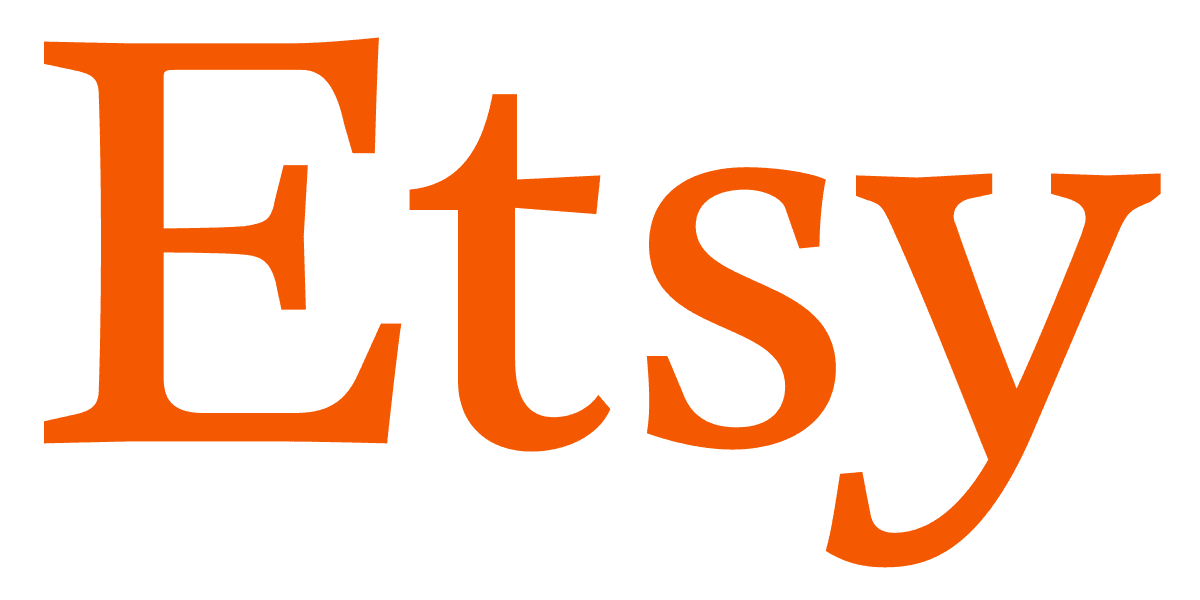
Etsy
Craft-focused marketplace
Easy setup
Low entry barriers
Global reach
High competition
High fees

Instagram
Social media
Global reach
Direct audience engagement
Time-consuming content creation
Algorithm limits
Limited selling functionality
Galleries
Traditional non-digital channels
Prestige
Personal interaction
High fees
Limited to physical presence
Harder for emerging artists to break in
define
Understanding how artists and buyers engage in the art sales journey.
Meet Cameron the emerging artist & John the buyer
To gain a comprehensive understanding of the art sales journey, we created personas for both the artist and the buyer. These personas guided our design process by highlighting their unique goals, pain points, and motivations.
artist
Cameron
Goals
Sell her work fairly to appreciative buyers.
Foster deeper audience connections.
Pain points
Hard to get exposure online.
Doesn’t know how to price her work.
buyer
John
Goals
Wants affordable, meaningful art that suits his home.
Pain points
Struggles to visualize online art in real life.
Gallery pieces feel overpriced and impersonal.
We stand on both sides to understand the whole picture.
The artist's and buyer's journeys highlight their challenges and room for improvement in the app's design.
Understanding both sides will help us better achieve artists' goals.
The two goals form the foundation for addressing the artists' pain points and opportunities identified in the journey map.
Earn money
Artists face significant challenges in pricing their work, securing sales, and building trust with buyers. These obstacles create anxiety and uncertainty, underscoring their need for a platform that simplifies sales and offers fair opportunities to monetize their efforts.
Build connections
From struggling to market their work to feeling disconnected post-sale, artists express a desire for more meaningful relationships with their audience. This reflects their need for tools that foster engagement, feedback, and long-term connections.
how might we
This question guided our design process and informed solutions that benefit both artists and buyers.
ideation
Prioritization based on matrices.
Drawing from user research insights, we selected two key matrices and prioritized our design solutions accordingly:
Earn money
Money matters—help artists to sustain their art career.
Build connections
Strengthening artists' connections with buyers, fellow artists, and the broader art community.
Next direction for design solutions?
From the insights, physical experience enhances personal interactions and allows buyers to view the art in person to enhance their confidence to buy art.
Two directions developed to ideate design solutions:
Do we want to connect the physical with the digital?
This would result in a solution that provides resources to help artists connect in real life.
Do we want to augment a physical experience with a digital product?
This would result in a solution that replicates an experience, such as an art marketplace, and transforms it into a digital product.
Design solution ideation
our idea
A location-based digital art marketplace that maximizes the value of artists' work and strengthens connections between emerging artists and buyers within local communities.
Research shows that more buyers are purchasing art through online platforms and apps. To bridge the gap between artists and buyers, we believe a mobile application offers the best mobility and visibility for artists to showcase their work and engage with buyers. Likewise, buyers can conveniently browse and purchase artwork anytime from their phones.
prototype
Focus on buyers only.
Due to space limitations, I am showcasing only the buyer's user flow, usability testing, and design version, as it better represents our solution.
Artist's journey
Buyer's journey
Legend
usability testing
Always test with users after we did something…
We tested with 5 target users.
We care about iteration because great design isn’t just about aesthetics—it’s about solving real problems effectively. Each cycle brings us closer to a product that is both functional and meaningful for users.
iteration
Transparent price breakdown
"If we provide a transparent price breakdown, buyers will perceive higher value in the artist's work."
2 out of 4 users appreciated the breakdown, stating it helped rationalize the pricing.
2 out of 4 users questioned the accuracy of the hours spent and the subjectivity of an artist's hourly wage.

Current design
vs.
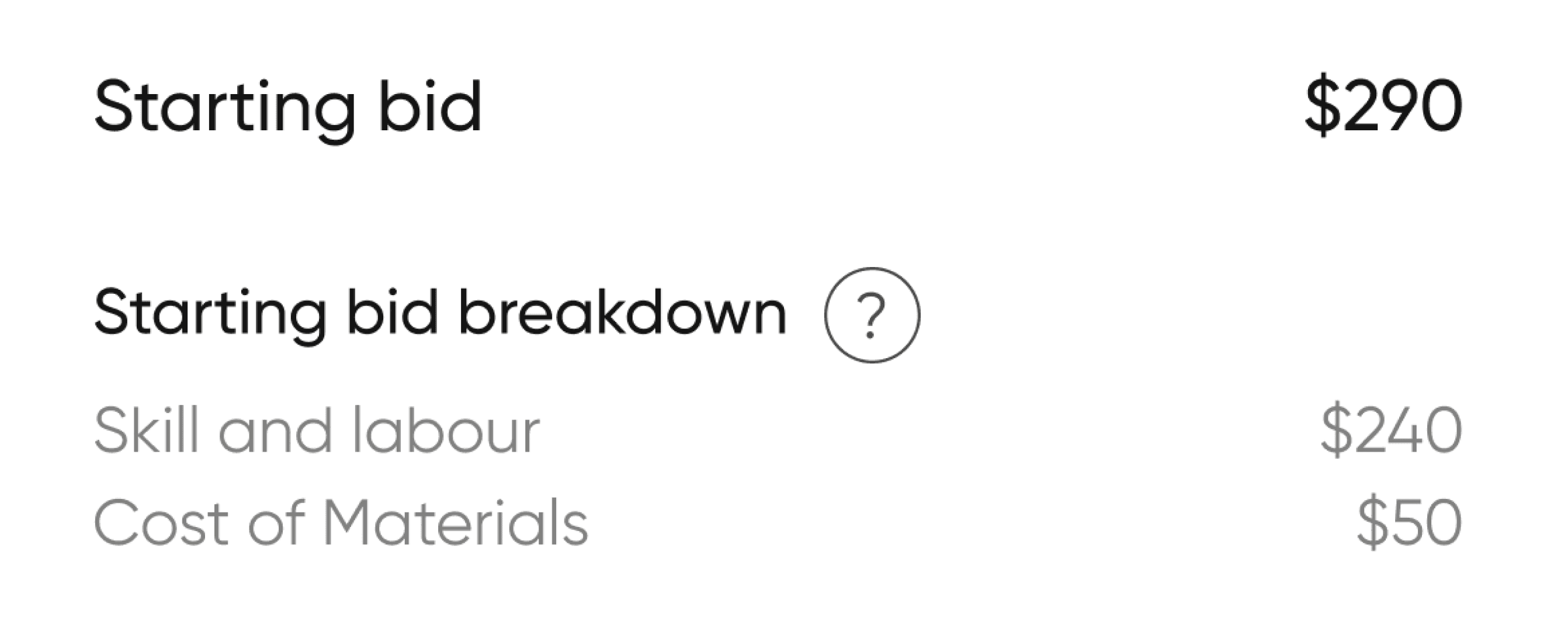
Proposed design
Book appointment to see artwork
"There are different paths to book an appointment with an artist. We want to see what path buyers choose the most."
3 out of 4 users couldn't find the button on the main page; instead, they clicked on the "Artist" tab and clicked on "Message" button.
Before

Appointment button under "Auction" tab
vs.
After

Appointment button under "Artist" tab
Auction with bid history
"If we introduce auction and bid history, buyers will better understand the artwork's value."
3 out of 4 users agreed that bid history helped with perceiving value.
But bidding makes the trend go up anyway. Is the line graph making sense?
If people stop bidding and make the line graph stop growing, it will emphasize the struggles, too.
Before

Line graph
or
After

New design of Bidding history
Next step: more usability testings!
Our usability testing showed that "hours spent" was deemed untrustworthy by users because artists can technically input any number of hours they want. We proposed another version of the price breakdown, which will undergo further usability testing to validate our assumption.
our solution
Artistry, a location-based digital art marketplace that maximizes the value of artists' work and strengthens connections between emerging artists and buyers within local communities.
Unique market position
By addressing gaps in existing platforms and combining innovative features like auctions, AR visualization, and transparent pricing, we’ve created a solution that empowers artists and enhances the buyer experience. Our platform bridges the gap between traditional galleries and modern digital tools, offering a unique hybrid solution.


discover art via map
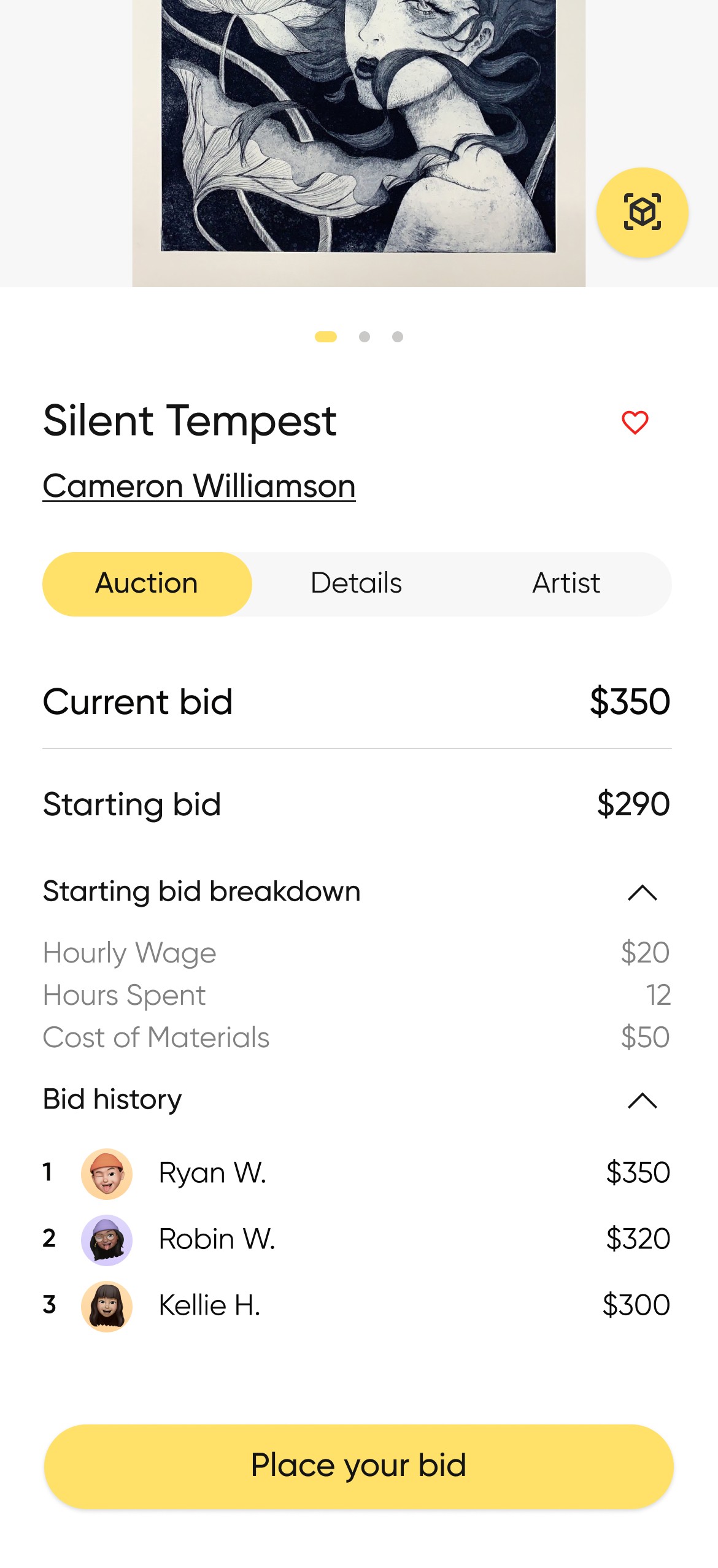



Artist-Centric Features
We prioritize artist autonomy by offering flexible pricing, lower fees, and tools to directly connect with their audience. Social features like updates, comments, and likes also help artists build relationships.
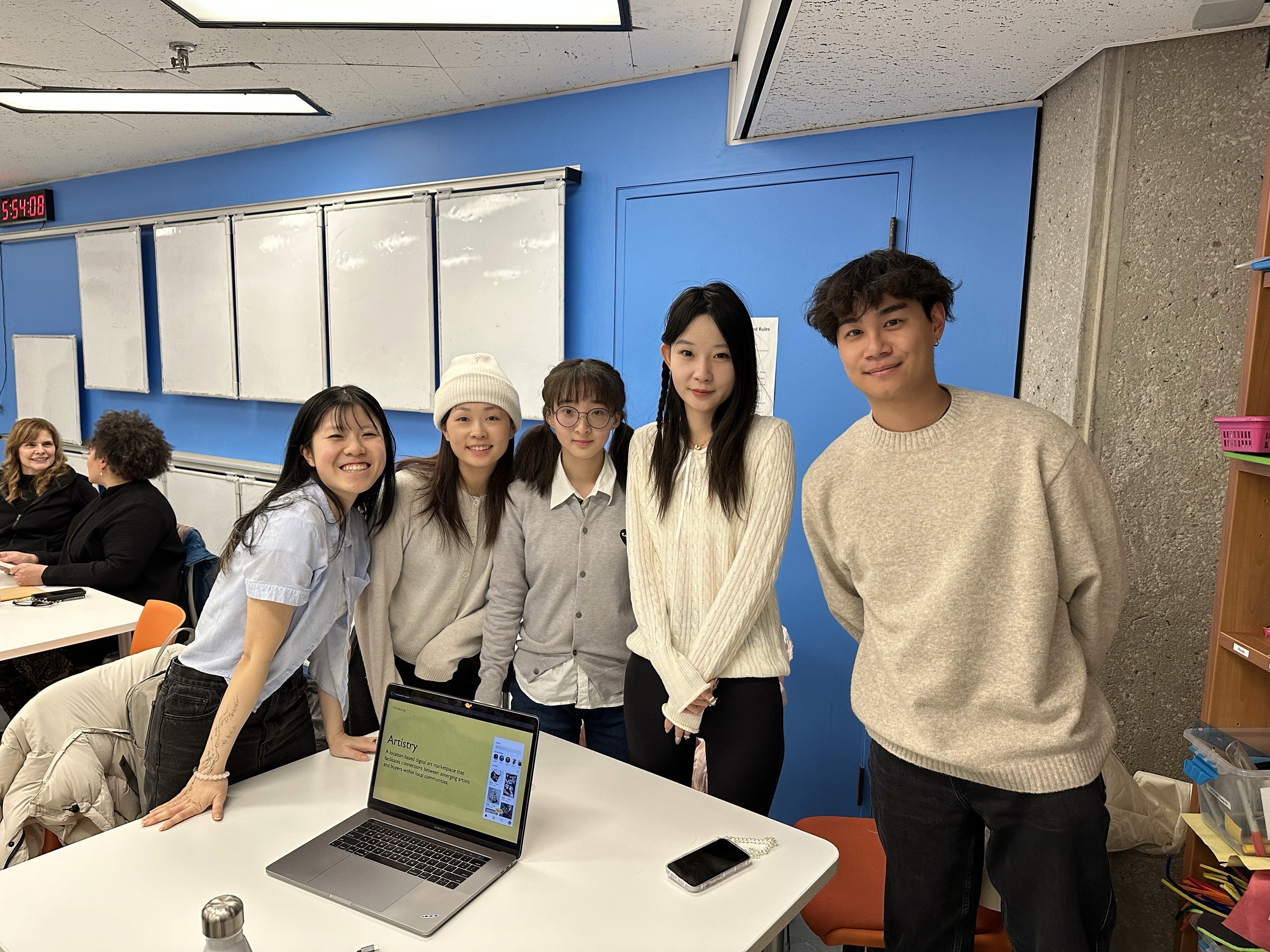
Diverse User Data: Broaden usability testing to include a more representative and diverse user group.
Feature Validation: Prioritize testing key features like appointment scheduling to ensure they meet user needs effectively.
thank you ♡
